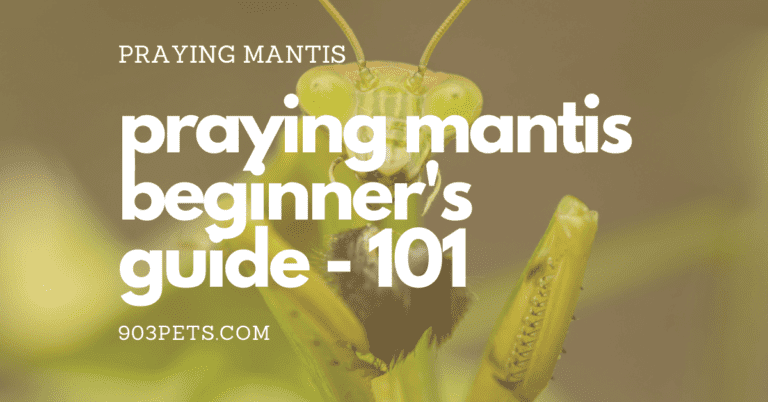Praying Mantis Egg Cases – Buyers Guide [Info & Tips]
Whether for managing garden pests or raising them as pets, praying mantises come from eggs laid by their mother in the fall and hatch in the spring.
But what else should we know about mantis eggs before buying them to hatch?
Let’s get into it.
![Praying Mantis Egg Cases - Buyers Guide [Info & Tips] 1](https://cdn-0.903pets.com/ifywhoft/2022/05/praying-mantis-egg-cases-buyers-guide.jpg)
What is a praying mantis egg sack (Cocoon) called?
![Praying Mantis Egg Cases - Buyers Guide [Info & Tips] 2](https://cdn-0.903pets.com/ifywhoft/2022/05/praying-mantis-ootheca-how-to-pronounce-1024x536.png)
A praying mantis egg sac is called an ootheca. The plural of ootheca is not oothecas, but actually oothecae. Love that scientific language.
The term ootheca (plural oothecae) comes from a combination of oo-, meaning “egg”, from the Greek word ōon, and theca, meaning a “cover” or “container”, from the Greek theke. It is used in biology to refer to the egg mass of some insects, especially cockroaches and mantises.
The ootheca is created by the female mantis after reaching adulthood. Laying an ootheca doesn’t mean she has mated. This means that oothecae can be infertile. There’s no way to know until you try to hatch them.
There is a false impression that mantids die after they create an ootheca, but this simply is not true. Most females will lay more than one ootheca in their lifetime.
Where can I buy praying mantis eggs?
Praying mantis eggs can be bought from a variety of places. One popular option is to buy them from a local garden center. This is because many gardeners think of mantises as beneficial insects that will reduce the aphid and other harmful insect populations in their gardens. Therefore many garden centers sell or can order, praying mantis ootheca that you can hatch yourself in the spring.
Another option is to buy them from an online retailer such as Amazon. Yes! Amazon does sell praying mantis egg cases, but be wary and pay attention to reviews to a point. Etsy is another option for those highly rated vendors like Ant Farm Supplies LLC.
You can also buy live mantises from a live insect vendor such as US Mantis. These are typically intended as pets and are too expensive to purchase in high quantities for application in a garden. But, this is how we typically obtain some of the rarer, and prettiest species as praying mantis pet owners.
We have all our recommended Praying Mantis gear and vendors fully listed on our gear page if it helps you quickly get tested supplies for your mantis.
[COMING SOON]
Where can I find praying mantis eggs in the wild?
In the wild, you can find praying mantis eggs in many different places. Praying mantis generally lay their eggs in the late summer or fall and they will lay their ootheca on the underside of leaves, often around or near a “Y” of the branching stem.
You can also find praying mantis eggs in outdoor Christmas trees. This is uncommon, but can happen.
How much do praying mantis eggs cost?
![Praying Mantis Egg Cases - Buyers Guide [Info & Tips] 3](https://cdn-0.903pets.com/ifywhoft/2022/05/Praying-Mantis-Ootheca-Prices-By-Vendor.png)
Praying mantis eggs (ootheca) are not cheap and they vary in price depending on the seller and the time of year they are purchased. They can cost anywhere from $4.49 to $27.00 per Ootheca, depending on where you buy them. The price per ootheca typically drops as you buy them in bulk.
We surveyed a number of vendors and compiled a table of prices for you below:
| Vendor | Price/Ootheca |
|---|---|
| Ant Farm Supplies, LLC. | $9.98 |
| Crittergrr (EBAY) | $24.99 |
| Bug Sales (AMAZON) | $4.65 |
| Nature’s Good Guys (AMAZON) | $4.65 |
| Nature’s Good Guys (EBAY) | $9.00 |
| Carolina Biological Supply Company | $7.42 |
| Arbico Organics | $4.49 |
| Praying Mantis Shop | $9.50 |
| US Mantis | $27.00 |
| US Mantis | $20.00 |
In our survey, the median price per ootheca was $9.25 and the Average price was $12.17.
What to look for when buying praying mantis eggs?
There are a few things to look for when buying praying mantis eggs.
- Seller’s reputation
- Freshness of Oothecae (<6 months)
- Satisfaction Guarantee (although most don’t)
One thing is to ensure that you are purchasing from a reputable seller. Good sellers will usually have information about the praying mantis species and egg sac in the product description so that you know what you are buying.
Another thing to look for is the condition of the egg sacs. Good sellers will provide details of whether their oothecae are wild-caught or raised in captivity. You want oothecae that have over-wintered and not older than about 6-8 months old.
![Praying Mantis Egg Cases - Buyers Guide [Info & Tips] 4](https://cdn-0.903pets.com/ifywhoft/2022/05/Mantis_ootheca_Sliced_open_Hierodula_patellifera-tiny.jpg)
Finally, while most sellers do not offer one, you might be interested in a satisfaction guarantee. Most sellers say there cannot promise that the ootheca will hatch because they don’t know if they are fertile or how old they are with certainty. Most will hatch, but upwards of 20% may not.
In our survey, only Carolina biological Supply Company offers a satisfaction guarantee that reads: “This product is backed by our 100% Satisfaction Guarantee. If for any reason you are not satisfied with any item, you may return it for a replacement, a refund, or credit. Read more about our Return and Exchange Policy »“
How long does the hatching process take?
As a general rule, praying mantis eggs will hatch 21-42 days after experiencing warm weather above 70 degrees Fahrenheit. Larger species of mantis may take up to 3 months to hatch. If you need to wait longer for the eggs to hatch, place them in the refrigerator for up to 90 days. Then, remove them from the fridge 21-42 days before the desired hatching. Do not place oothecae in airtight containers as they need airflow around them.
The hatching process itself takes place over 1-2 hours. When the hatching event begins, all the eggs will hatch at the same time. The praying mantis nymphs will appear on the exterior of the ootheca and may suspend themselves on silky threads. Within the hour, they will drop to the ground and begin looking for food.
It is difficult to tell if the ootheca has hatched if you did not witness the event unless you can find praying mantis nymphs around the ootheca. The shape, size, and color do not change as a result of the hatching event. The only indication that the ootheca has hatched is that you may be able to small holes where the nymphs emerged from but even then you can’t be 100% sure.
When in doubt, try to hatch it at the appropriate time. After 90 days, you’ll know for sure.
What does a praying mantis egg sac look like? (describe the physical characteristics)
![Praying Mantis Egg Cases - Buyers Guide [Info & Tips] 5](https://cdn-0.903pets.com/ifywhoft/2022/05/Mantis_egg_2005_Spring_001.jpg)
Praying mantis eggs are a bit different from insect eggs in that they are contained in a sac, called an ootheca. The ootheca is a brown, leathery-looking, round sac and can be about 1 inch in diameter. The eggs are laid in the ootheca in a cluster and the eggs will hatch within a couple of hours.
Each ootheca can contain 50-300 mantis eggs. This is a remarkable number of mantis babies. The quantity of eggs in an ootheca depends on the species of mantis that lay them. However, in the wild, only about 20% of the hatchling nymphs will make it to adulthood. The journey to adulthood covers many stages as described in our article about praying mantis lifespans.
Can I move a praying mantis egg sac?
![Praying Mantis Egg Cases - Buyers Guide [Info & Tips] 6](https://cdn-0.903pets.com/ifywhoft/2022/05/1024px-Praying_Mantis_Mantis_religiosa_religiosa_Ootheca_06.jpg)
Once the ootheca has hardened, usually within a few days of being made, it can be safely moved. However, you do want to ensure the ootheca is suspended and left alone until it hatches once placed in its new location.
For wild oothecae, you can safely snip the branch 2-3 inches above and below the ootheca to make it more manageable to take indoors or move to your garden.
Securing the ootheca in its new location should be done with string or plant wire wrapping only around the branch ends, not the ootheca itself.
When do praying mantises lay their eggs?
The best time to look for praying mantises to be actively laying eggs is in the fall. The eggs will be deposited in an egg case that the female will carry around with her until they hatch. The egg case will be attached to a plant or other object.
The best time to look for wild ootheca (egg cases) that will be ready for hatching is in the late winter or early spring before temperatures get above 60 degrees Fahrenheit. If you find an ootheca in the wild, you can bring it home and incubate it until the baby mantises hatch.
Summary
Praying mantis eggs are contained in a sac, called an ootheca. The ootheca is a brown, leathery-looking, round sac and can be about 1 inch in diameter. The eggs are laid in the ootheca in a cluster and will hatch the following spring. Each ootheca can contain 50-300 mantis eggs.
Buying praying mantis eggs (ootheca) is not cheap and they vary in price depending on the seller and the time of year they are purchased. Early spring is usually the least expensive time of year. In our survey, the median price per ootheca was $9.25 and the average price was $12.17.
There are a few things to look for when buying praying mantis eggs, such as the seller’s reputation, the freshness of the ootheca (<6 months), and the satisfaction guarantee (although most don’t offer one).
As a general rule, praying mantis eggs will hatch 21-42 days after experiencing warm weather above 70 degrees Fahrenheit. The hatching process itself takes place over 1-2 hours. When the hatching event begins, all the eggs will hatch at the same time.
If you think your pet is ill, call a vet immediately. All health-related questions should be referred to your veterinarian. They can examine your pet, understand its health history, and make well informed recommendations for your pet.
903pets.com Staff





![Insect Pets - Which Insects Make The Best Pets? [12 Answers] 13 Insect Pets – Which Insects Make The Best Pets? [12 Answers]](https://cdn-0.903pets.com/ifywhoft/2022/01/insect-pets-are-they-right-for-you-768x402.jpg)

![10 Snail Friendly Plants for a Terrarium [Care Instructions] 16 10 snail safe terrarium plants](https://cdn-0.903pets.com/ifywhoft/2021/04/10-snail-safe-terrarium-plants-768x402.jpg)